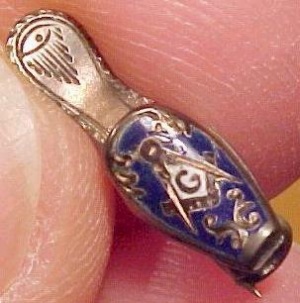En:Blue slippers
The Masonic Blue Slipper
Source: Phoenixmasonry
by Bro Clyde H. Magee, 32°
He belonged to Unity Lodge 146 in Front Royal, Virginia and was also a member of the Eastern Star chapter there.
Are you familiar with the Masonic Blue Slipper? It is a small lapel pin in the shape of a blue slipper. Over the years it has been my habit to ask my wife and daughters to wear one of these slippers on a coat or dress when traveling alone away from home. What is the meaning of the blue slipper and why should female relatives of Masons wear one?
Some 50 or 60 years ago while I was still living at home, a widowed lady, who was a cousin of my dad’s, came to visit our home every year. Her late husband was a Mason. The pin that she wore - the blue slipper - made a lasting impression on me. She told me that it was a Masonic pin and served to identify her as a Masonic Widow.
To find out the meaning of the pin, we have to go back in history to the time of Boaz - to be found in the book of Ruth. This is the well known story of Naomi returning to her own land after the death of her husband, Elimelech, and her sons. One daughter in-law, Ruth, a Moabite, accompanied her mother-in-law back to Bethlehem Judah but, both were destitute. Ruth went to work in the fields to enable her to look after her mother-in-law. However, the law of the land stated that Elimelech’s next of kin was duty bound to redeem his possessions and look after his widow and off-spring. The next of kin refused to do so. Boaz offered to become the redeemer of Elimelech’s property - a proposition that the next of kin accepted. To seal the bargain, Boaz and the next of kin met at the city gates in the presence of the elders. The next of kin drew off his shoe and handed it to Boaz as a token of the bargain. Boaz held the shoe up for all to see - he asked them to be witnesses that he had become Naomi’s protector, Ruth’s husband and a redeemer of Elimelech’s property. Thus today we have the little blue slipper as an emblem of the protective influence of Masons for their wives, widows and daughters.

